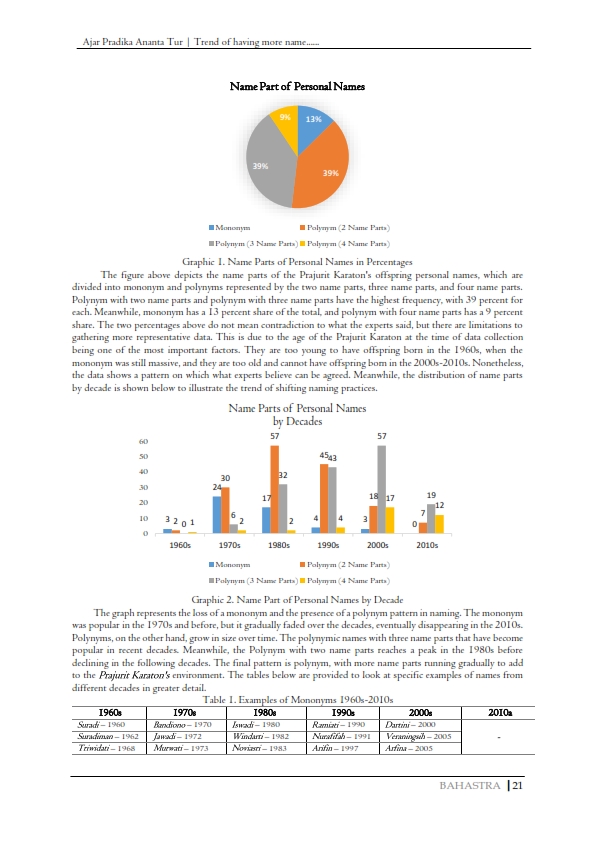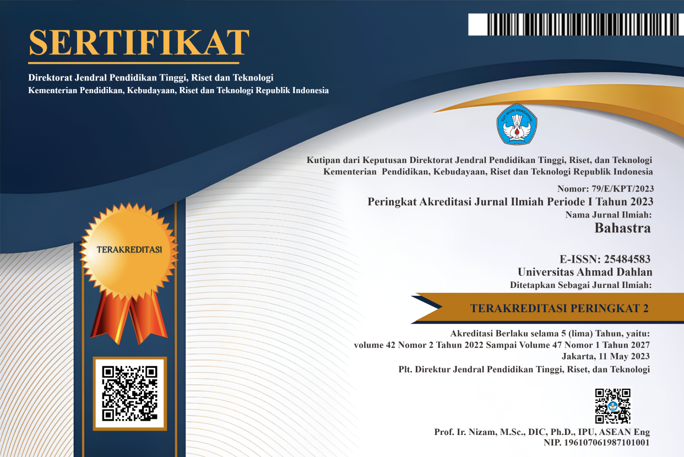Trend of Having More Name Parts in Homogeneous Community
DOI:
https://doi.org/10.26555/bs.v42i1.66Keywords:
Key word: Javanese Culture Homogeneous Community Mononyms Polynyms Royal Palace Soldier (Prajurit Karaton)Abstract
The intersection of loyalty to tradition among Prajurit Karaton and the demands of the times, particularly in terms of naming, is a topic that deserves to be researched. Furthermore, the community characteristics that are usually raised in scientific writings about naming are heterogeneous communities, so homogeneous communities become an important supporting component that completes the topic. This is a qualitative study that uses the Prajurit Karaton as the primary data source and a list of the names of their offspring as the secondary data. As a result, the names of the Prajurit Karaton’s offspring changed from mostly mononyms in the 1960s to polynyms in the 2010s. Nonetheless, the identity of a Javanese society remains. This also demonstrates that the Prajurit Karaton give names in accordance with the times while maintaining their identity as Javanese people and the Javanese cultural values.
References
Aribowo, E. K. (2017). Linking Arabic, Islam, and Economy: Onomastics on Business Name of People of Arab Descent in Indonesia. Karsa: Journal of Social and Islamic Culture, Vol 25(2), p. 284-306. http://ejournal.iainmadura.ac.id/index.php/karsa/article/view/1390
Aribowo, E. K., & Herawati, N. (2016). Trends in naming system on Javanese society: A shift from Javanese to Arabic. Lingua Cultura, 10(2), p. 117-122. http://dx.doi.org/10.21512/lc.v10i2.1730
Aribowo, E. K., Hadi, S., & Ma’ruf, A. (2019). Similar but not the same: How to identify the name of Arab descendent and the Arabic name of Javanese. Arabi: Journal of Arabic Studies, Vol. 4(2), p. 115-126. https://doi.org/10.24865/ajas.v4i2.154
Atmawati, D. (2020). The shift of proper names among Javanese society: A sociolinguistic study. Advances in Social Science, Education, and Humanities Research, Vol. 509, p. 202-207. https://doi.org/10.2991/assehr.k.201215.031
Bertills, Y. (2003). Beyond identification: Proper names in children’s literature. Abo: Abo Academi University Press. http://bibbild.abo.fi/ediss/2003/BertillsYvonne.pdf
Bloothooft, G. & Groot, L. (2008). Name clustering on the basis of parental preferences. Names 56, p. 111-163. https://doi.org/10.1179/175622708X332851
Bloothooft, G. & Onland, D. (2011). Socioeconomic determinants of first names, Names 59, p. 25-41. https://doi.org/10.1179/002777311X12942225544679
Chen, L. N. H. (2015). Choices and patterns of English names among Taiwanese students. Names, 63:4, p. 200-209.
Cheng, K. K. Y. (2008). Names in multilingual-multicultural Malaysia. Names, 56:1, p. 47-53. https://doi.org/10.1179/175622708X282965
Coulmas, F. & Guerini, F. (2012). Literacy and writing reform. In B. Spolsky (ed.), The Cambridge Handbook of Language Policy, p. 454. Cambridge: Cambridge University Press. http://assets.cambridge.org/97805211/95652/frontmatter/9780521195652_frontmatter.pdf
Fitria & Tur, A. P. A. (2019). From abstract to concrete: associating the users’ tweets on “success”. Indoensian Journal of EFL and Linguistics, Vol. 4(2), p. 121-134. http://dx.doi.org/10.21462/ijefl.v4i2.136
Haggan, M. (2008). Nicknames of Kuwaiti teenagers. Names 56, p. 81-94. https://doi.org/10.1179/175622708X302368
Hanks, P. (2003). Americanization of European family names in the seventeenth and eighteenth centuries. Onoma 38, p. 119-154.
https://doi.org/10.1080/00277738.2015.2228986
Kratonjogja.id. (2016). Cikal bakal keraton Kasultanan Yogyakarta (2 Agustus 2016). Retrieved at 9 February 2021 from https://www.kratonjogja.id/cikal-bakal/detail
Kratonjogja.id. (2016). Tugas dan fungsi abdi dalem (2 Agustus 2016). Retrieved at 22 January 2021 from https://www.kratonjogja.id/abdi-dalem/3/tugas-dan-fungsi-abdi-dalem
Kratonjogja.id. (2017). Bregada prajurit keraton Yogyakarta (18 September 2017). Retrieved at 15 February 2021 from https://www.kratonjogja.id/prajurit/2/bregada-prajurit-keraton-yogyakarta
Kuipers, J. C. & Askuri. (2017). Islamization and identity in Indonesia: The case of Arabic names in Java. Indonesia 103, p. 1-25. https://doi.org/10.5728/indonesia.103.0025
Lefman, G. (2013). Internationalization of People Names. Master Thesis, University of Limerick http://hdl.handle.net/10344/3450
Lombard, C. G. (2011). The Sociocultural significance of Niitsitapi personal names: An ethnographic analysis. Names 59, 42-51. https://doi.org/10.1179/002777311X129422255447144
Mensah, E. O. (2020). Name this child: Religious identity and ideology in Tiv
personal names. Names, p. 1-15. https://doi.org/10.1080/00277738.2020.1731239
Plungyan, V. A. (2011). Modern linguistic typology. Herald of the Russian Academy of Sciences, Vol. 81, p. 101–113. https://doi.org/10.1134/S1019331611020158
Prabandari, C. S. (2017). Current trend in naming babies in Javanese community. International Journal of Humanity Studies, Vol. 1(1), p. 63-70. https://doi.org/10.24071/ijhs.2017.010107
Rony, A. K. (1970). Indonesian names: A guide to bibliographic listing. Indonesia Vol 10, p. 27-36. https://www.jstor.org/stable/3350633
Sercombe, P., Young, T., Dong, M., and Lin, L. (2014). The adoption of non-heritage names among Chinese mainlanders. Names, 62(2), p. 65-75. https://doi.org/10.1179/0027773813Z.00000000071
Sulistiyowati. (2014). Artikulasi Identitas Wong Solo di Eks-Enklave Surakarta: Konstruksi Bahasa dan Pemertahannya. Humaniora, 26(2), p. 149-163. https://jurnal.ugm.ac.id/jurnal-humaniora/article/view/5238
Sulistyawati. (2004). Nama dan gelar di keraton Yogyakarta. Humaniora Vol 16(3), p. 263-275. https://jurnal.ugm.ac.id/index.php/jurnal-humaniora/article/view/1306
Tan, P. K. W. (2006). Towards a standardization of personal names: The case of the ethnic Chinese in Singapore. Names, 54(4), p. 291-319. https://doi.org/10.1179/nam.2006.54.4.291
Tur, A. P. A. (2019 a). Iconic English business name as a branding tool in the rural areas of Yogyakarta special region. LITERA, Vol. 18(1), p. 136-149. https://journal.uny.ac.id/index.php/litera/article/view/20736/pdf
Tur, A. P. A. (2019 b). Patterns of linguistic features in private chats of social media account leading someone to be a victim of a cybercrime. LEKSIKA, Vol. 13(1), p. 29-38. https://doi.org/10.30595/lks.v13i1.3858
Uhlenbeck, E. M. (1969). Systematic Features of Javanese Personal Names. Word, Vol. 25: 1-3, p. 31-335. https://doi.org/10.1080/00437956.1969.11435576
Uhlenbeck, E. M. 1982. Kajian Morfologi Bahasa Jawa. Jakarta: Penerbit Djambatan.
Van Langendonck, W. & Van de Velde, M. (2018). Names and grammar. In C. Hough, The Oxford handbook of names and naming, p. 17-38. Oxford: Oxford University Press.
Van Langendonck, W. (2007). Theory and typology of proper names: Trends in linguistics. Studies and Monographs Vol. 168. New York: Mouton de Gruyter. https://doi.org/10.1515/9783110197853
Warren, S. D. (2015). Naming regulations and indigenous rights in Argentina. Sociological Forum, Vol. 30(3), p. 764-786. https://www.jstor.org/stable/43654132
Wening, S. (2015). Nama Diri pada Masyarakat Jawa di Yogyakarta. A Dissertation. Universitas Gadjah Mada.
Wibowo, R. M. (2001). Nama diri etnik Jawa. Humaniora, Vol 13(1), p. 45-55. https://jurnal.ugm.ac.id/jurnal-humaniora/article/view/710
Widodo, S. T. (2013). Konstruksi nama orang Jawa: Studi kasus nama-nama modern di Surakarta. Humaniora, Vol 25(1), p. 82-91. https://jurnal.ugm.ac.id/jurnal-humaniora/article/view/1815
Widodo, S. T., Yussof, N., & Dzakiria, H. (2010). Nama orang Jawa: Kepelbagaian unsur dan maknanya. Proceeding, Sari - International Journal of the Malay World and Civilisation, 28(2), p. 259 – 277. http://journalarticle.ukm.my/1271/.

Downloads
Published
Issue
Section
License
Copyright (c) 2022 Ajar Pradika Ananta Tur

This work is licensed under a Creative Commons Attribution-ShareAlike 4.0 International License.

1.jpg)






